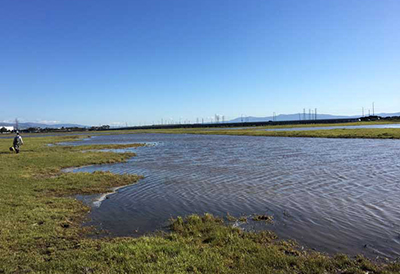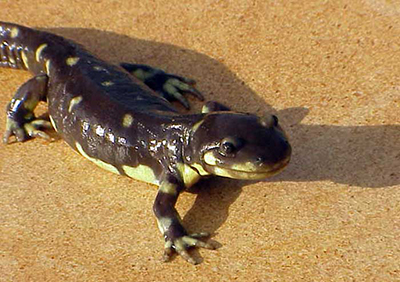
“My grandfather was an environmentalist,” said Frank Imhof. “... he just wouldn’t have thought to put it that way.” like both his grandfathers and his father, Imhof is a rancher, a cattleman. Now he’s training his son, Frank Jr.—better known as Frankie—to take over the business.
But it’s a challenge in the densely populated San Francisco Bay Area, where grazing lands for cattle have been squeezed out by sprawling development. That’s why the partnership between the Imhofs and the U.S. Fish and Wildlife Service (Service) is so important. Through a public-private agreement, the ranchers graze their cattle on a 719-acre vernal pool grassland at the Warm Springs unit of the Don Edwards San Francisco Bay National Wildlife Refuge in Fremont, California.
With this pact, they’re keeping alive a ranching and land stewardship heritage spanning four generations. The grazing, in turn, offers a host of benefits for endangered species at the seasonal pond.
“Keeping the grass short controls non-native grasses and increases germination for native vernal pool plants like the endangered Contra Costa goldfield,” said wildlife refuge specialist Ivette Loredo, who manages the Warm Springs unit for the Service.
Grazing also benefits other wildlife. For endangered vernal pool tadpole shrimp and threatened California tiger salamanders, it reduces non-native grasses that suck up water and shorten the seasonal lifespan of pool breeding habitats. For burrowing owls, a species of special concern in the state of California, and ground squirrels, which dig burrows used by the owls and salamanders, grazing helps them detect predators like foxes and hawks.
The refuge maintains several small, ungrazed “exclosures” — areas where cattle are not allowed — as a yardstick for comparison with the grazed area. Loredo often leads tours of the site, using the exclosures as a teaching tool. Inside the small, fenced-off areas, non-native grasses grow in thick clusters as high as three feet, choking out native plants. It’s a dramatic contrast to the flourishing Contra Costa goldfields and other colorful flowers on the surrounding land, where, rain allowing, vernal pools form seasonally.
The grazing arrangement between the Imhofs and the Service dates back to 2004, when it started with just 25 cows. Now, ranchers rotate groups from about 100 cattle among 10 fenced fields. Imhof senior raises the cattle to sell for beef. His son does selective breeding to raise certain cattle for shows.
The Service determines market rate for grazing fees and uses that figure to calculate the amount of other in-kind work the ranchers have to do to cover it. That work can include construction of exclosure sites and help with restoration—projects that offer a learning experience for the ranchers, as well. It’s clear, watching them on the land, that they take their work to heart.
“We try to maintain good cow practices,” the younger Imhof said. “The main thing is talking to the cows, not yelling at them. Every time we move them, we want them to have a good experience.”

The rotation is guided by a spreadsheet with targets for grazing in each field.
“We’re also looking at the nutritional value for the cows,” he added. “If we think they’re getting too fat, or not fat enough, we’ll move them.” A bonus for the refuge is having the ranchers’ eyes and ears at the site every day.
“These guys are constantly telling us when they spot owls in the fields, when maintenance needs to be done, or if they see trespassers,” Loredo said.
That kind of information is crucial for a refuge staff stretched thin in managing more than 30,000 acres. So is the knowledge the ranchers bring from their years of history with the land.
“I was out here irrigating when I was 16, and I’m 57 now,” said the elder Imhof. “My grandfather had dairy cows in the hills here in 1929.”
A connection to the land is a living tradition in the Imhof family. Both of the senior Imhof’s sons and his daughter were in Future Farmers of America and the 4-H.
“A lot of people in this area now don’t even know about the history with ranching here,” his son pointed out. “They’re amazed when I tell them we do cattle grazing in Fremont.”
His father added: “Without what the Service is doing here, this would have all been developed. And this will still be here in 50 years.” The Imhofs believe that their grazing partnership with the refuge offers useful lessons for conservationists, school groups and others who tour the site.
“It’s showing people that what we do out here with grazing cattle doesn’t harm the environment,” said the elder Imhof. In fact, as his son noted, it’s helping.
“What better way are you going to have to pick these seeds up, fertilize them and spread them out?” said the younger Imhof. The benefits cascade to the goldfields, the owls and even the salamanders. They agree that the collaborative effort is working well.
“We’re very fortunate to be here, and Ivette has worked with us a lot,” Frankie said. “She understands how our operation works.”
“She taught me a lot,” Frank Sr. offered, as Loredo stood alongside, smiling, “and I taught her a lot.”
 Sign In
Sign In
 Sign In
Sign In
